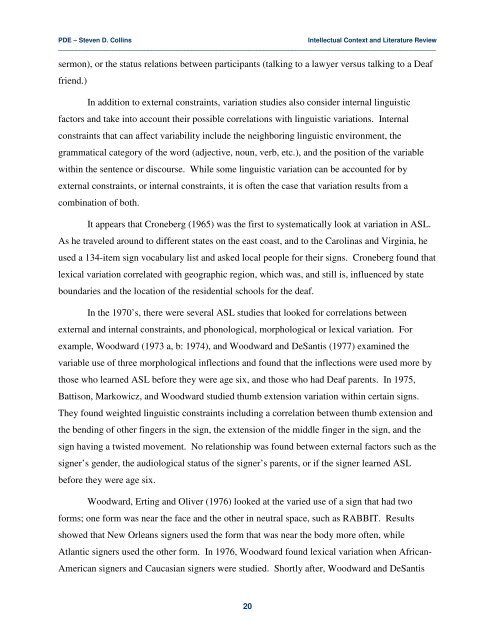Adverbial Morphemes in Tactile ASL - Gallaudet University
Adverbial Morphemes in Tactile ASL - Gallaudet University
Adverbial Morphemes in Tactile ASL - Gallaudet University
You also want an ePaper? Increase the reach of your titles
YUMPU automatically turns print PDFs into web optimized ePapers that Google loves.
PDE – Steven D. Coll<strong>in</strong>s<br />
Intellectual Context and Literature Review<br />
_________________________________________________________________________________________________________<br />
sermon), or the status relations between participants (talk<strong>in</strong>g to a lawyer versus talk<strong>in</strong>g to a Deaf<br />
friend.)<br />
In addition to external constra<strong>in</strong>ts, variation studies also consider <strong>in</strong>ternal l<strong>in</strong>guistic<br />
factors and take <strong>in</strong>to account their possible correlations with l<strong>in</strong>guistic variations. Internal<br />
constra<strong>in</strong>ts that can affect variability <strong>in</strong>clude the neighbor<strong>in</strong>g l<strong>in</strong>guistic environment, the<br />
grammatical category of the word (adjective, noun, verb, etc.), and the position of the variable<br />
with<strong>in</strong> the sentence or discourse. While some l<strong>in</strong>guistic variation can be accounted for by<br />
external constra<strong>in</strong>ts, or <strong>in</strong>ternal constra<strong>in</strong>ts, it is often the case that variation results from a<br />
comb<strong>in</strong>ation of both.<br />
It appears that Croneberg (1965) was the first to systematically look at variation <strong>in</strong> <strong>ASL</strong>.<br />
As he traveled around to different states on the east coast, and to the Carol<strong>in</strong>as and Virg<strong>in</strong>ia, he<br />
used a 134-item sign vocabulary list and asked local people for their signs. Croneberg found that<br />
lexical variation correlated with geographic region, which was, and still is, <strong>in</strong>fluenced by state<br />
boundaries and the location of the residential schools for the deaf.<br />
In the 1970’s, there were several <strong>ASL</strong> studies that looked for correlations between<br />
external and <strong>in</strong>ternal constra<strong>in</strong>ts, and phonological, morphological or lexical variation. For<br />
example, Woodward (1973 a, b: 1974), and Woodward and DeSantis (1977) exam<strong>in</strong>ed the<br />
variable use of three morphological <strong>in</strong>flections and found that the <strong>in</strong>flections were used more by<br />
those who learned <strong>ASL</strong> before they were age six, and those who had Deaf parents. In 1975,<br />
Battison, Markowicz, and Woodward studied thumb extension variation with<strong>in</strong> certa<strong>in</strong> signs.<br />
They found weighted l<strong>in</strong>guistic constra<strong>in</strong>ts <strong>in</strong>clud<strong>in</strong>g a correlation between thumb extension and<br />
the bend<strong>in</strong>g of other f<strong>in</strong>gers <strong>in</strong> the sign, the extension of the middle f<strong>in</strong>ger <strong>in</strong> the sign, and the<br />
sign hav<strong>in</strong>g a twisted movement. No relationship was found between external factors such as the<br />
signer’s gender, the audiological status of the signer’s parents, or if the signer learned <strong>ASL</strong><br />
before they were age six.<br />
Woodward, Ert<strong>in</strong>g and Oliver (1976) looked at the varied use of a sign that had two<br />
forms; one form was near the face and the other <strong>in</strong> neutral space, such as RABBIT. Results<br />
showed that New Orleans signers used the form that was near the body more often, while<br />
Atlantic signers used the other form. In 1976, Woodward found lexical variation when African-<br />
American signers and Caucasian signers were studied. Shortly after, Woodward and DeSantis<br />
20
















